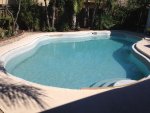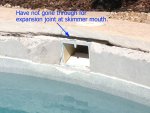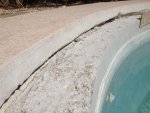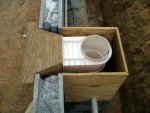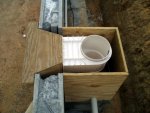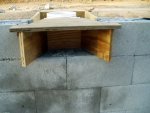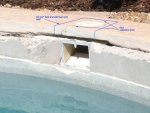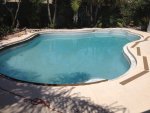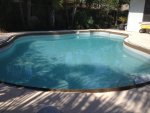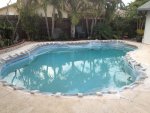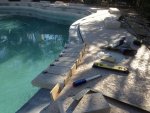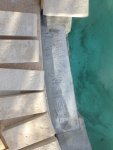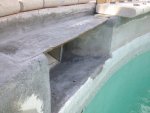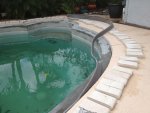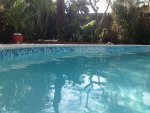Finding a lot of great info here so thanks to all that have posted and added input.
I am replacing the waterline tile and coping on my IG pool in South Florida. The new tile will be 3/4 x 3/4 glass mosaic and the new coping will be 4x8x1.5 cast concrete bullnose pavers.
So far, I have removed the old coping & 2" mud bed from the beam, the old ceramic tile & thinset, and hacked/sawed/chipped my way around the pool to separate the poured concrete deck from the pool beam. I will install 1/2" Deck-o-foam and Deck-o-seal to serve as an expansion joint between the deck and pool wall/coping. It looked as though the original PB (or someone else) added concrete between the pool wall and deck to fuse them together. Lack of an expansion joint was popping off the old coping and tile.
The 2 pool renovators that came out to quote this project before I decided to do it myself both said that an expansion joint isn't necessary. I disagree... while there's no frost here in sunny South Fla, I imagine that concrete anywhere will expand and contract to a certain degree and require this expansion joint. Proof is the old coping and tile that were cracked and popped off.
Here's what it looks like now:
[attachment=2:1mn2ctmd]IMG_2539.jpg[/attachment:1mn2ctmd]
Here's a detail of the top of the beam and pool deck:
[attachment=0:1mn2ctmd]IMG_2541.jpg[/attachment:1mn2ctmd]
My next steps are to put up temporary masonite forms around the whole pool to install the mud bed for the coping and coping pavers; waterproof the tile area and install tiles; caulk between tile top and coping bottom, patch some minor damage to the diamondbrite with EZ Pool Patch, repair and re-paint concrete deck and install Deck-o-seal around pool joint.
I have two questions if someone more knowledgeable than I can provide the answers. I realize there are several different ways to accomplish the same task, especially when it comes to masonry and construction.
1. The coping mud bed - I plan to cover the top of the pool beam with bonding agent, lay down a 1/4" layer of Megaflex thinset followed by a dry Portland cement/sand/acrylic mixture at the same time (going over the thinset before it sets. My question is should I allow this mud bed to cure before adding the coping later, or would it be possible to back butter the coping pavers with thinset at the same time and lay them right on top of the mud bed as I go along? The mud bed will be about 2.5 inches at it's deepest point, but about an inch in most places. And if the pavers go in at the same time is it possible to wet cure everything?
2. I did not separate the pool deck from the pool wall at the skimmer mouth. Should I leave this as is, or hack through this area as well? Here's a photo of what I'm referring to:
[attachment=1:1mn2ctmd]skimmermouth.jpg[/attachment:1mn2ctmd]
Thanks so much for any input!
I am replacing the waterline tile and coping on my IG pool in South Florida. The new tile will be 3/4 x 3/4 glass mosaic and the new coping will be 4x8x1.5 cast concrete bullnose pavers.
So far, I have removed the old coping & 2" mud bed from the beam, the old ceramic tile & thinset, and hacked/sawed/chipped my way around the pool to separate the poured concrete deck from the pool beam. I will install 1/2" Deck-o-foam and Deck-o-seal to serve as an expansion joint between the deck and pool wall/coping. It looked as though the original PB (or someone else) added concrete between the pool wall and deck to fuse them together. Lack of an expansion joint was popping off the old coping and tile.
The 2 pool renovators that came out to quote this project before I decided to do it myself both said that an expansion joint isn't necessary. I disagree... while there's no frost here in sunny South Fla, I imagine that concrete anywhere will expand and contract to a certain degree and require this expansion joint. Proof is the old coping and tile that were cracked and popped off.
Here's what it looks like now:
[attachment=2:1mn2ctmd]IMG_2539.jpg[/attachment:1mn2ctmd]
Here's a detail of the top of the beam and pool deck:
[attachment=0:1mn2ctmd]IMG_2541.jpg[/attachment:1mn2ctmd]
My next steps are to put up temporary masonite forms around the whole pool to install the mud bed for the coping and coping pavers; waterproof the tile area and install tiles; caulk between tile top and coping bottom, patch some minor damage to the diamondbrite with EZ Pool Patch, repair and re-paint concrete deck and install Deck-o-seal around pool joint.
I have two questions if someone more knowledgeable than I can provide the answers. I realize there are several different ways to accomplish the same task, especially when it comes to masonry and construction.
1. The coping mud bed - I plan to cover the top of the pool beam with bonding agent, lay down a 1/4" layer of Megaflex thinset followed by a dry Portland cement/sand/acrylic mixture at the same time (going over the thinset before it sets. My question is should I allow this mud bed to cure before adding the coping later, or would it be possible to back butter the coping pavers with thinset at the same time and lay them right on top of the mud bed as I go along? The mud bed will be about 2.5 inches at it's deepest point, but about an inch in most places. And if the pavers go in at the same time is it possible to wet cure everything?
2. I did not separate the pool deck from the pool wall at the skimmer mouth. Should I leave this as is, or hack through this area as well? Here's a photo of what I'm referring to:
[attachment=1:1mn2ctmd]skimmermouth.jpg[/attachment:1mn2ctmd]
Thanks so much for any input!


